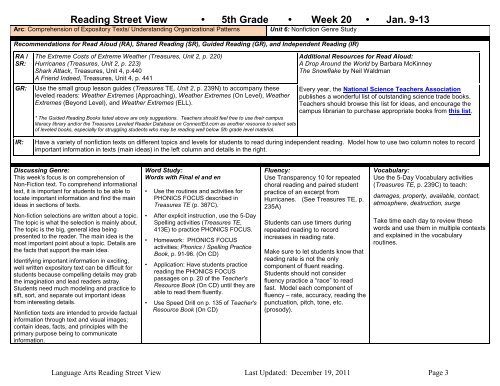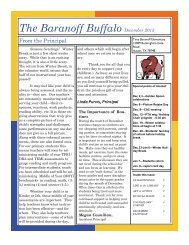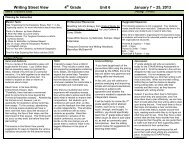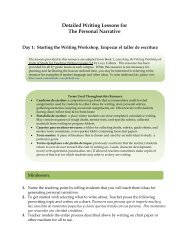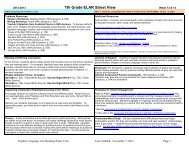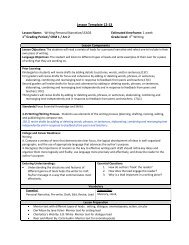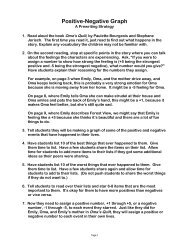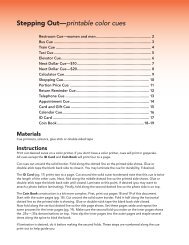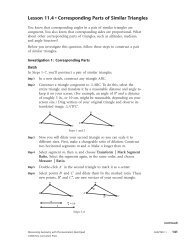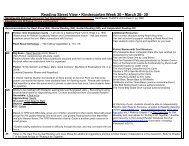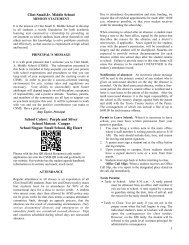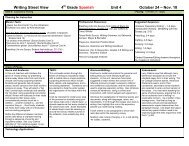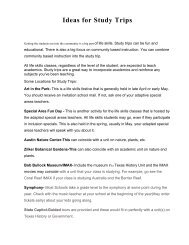Reading street view • 5th grade • week 19 • jan. 5-6
Reading street view • 5th grade • week 19 • jan. 5-6
Reading street view • 5th grade • week 19 • jan. 5-6
You also want an ePaper? Increase the reach of your titles
YUMPU automatically turns print PDFs into web optimized ePapers that Google loves.
<strong>Reading</strong> Street View • <strong>5th</strong> Grade • Week 20 • Jan. 9-13Arc: Comprehension of Expository Texts/ Understanding Organizational Patterns Unit 6: Nonfiction Genre StudyRecommendations for Read Aloud (RA), Shared <strong>Reading</strong> (SR), Guided <strong>Reading</strong> (GR), and Independent <strong>Reading</strong> (IR)RA /SR:GR:IR:The Extreme Costs of Extreme Weather (Treasures, Unit 2, p. 220)Hurricanes (Treasures, Unit 2, p. 223)Shark Attack, Treasures, Unit 4, p.440A Friend Indeed, Treasures, Unit 4, p. 441Use the small group lesson guides (Treasures TE, Unit 2, p. 239N) to accompany theseleveled readers: Weather Extremes (Approaching), Weather Extremes (On Level), WeatherExtremes (Beyond Level), and Weather Extremes (ELL).* The Guided <strong>Reading</strong> Books listed above are only suggestions. Teachers should feel free to use their campusliteracy library and/or the Treasures Leveled Reader Database on ConnectEd.com as another resource to select setsof leveled books, especially for struggling students who may be reading well below <strong>5th</strong> <strong>grade</strong> level material.Additional Resources for Read Aloud:A Drop Around the World by Barbara McKinneyThe Snowflake by Neil WaldmanEvery year, the National Science Teachers Associationpublishes a wonderful list of outstanding science trade books.Teachers should browse this list for ideas, and encourage thecampus librarian to purchase appropriate books from this list.Have a variety of nonfiction texts on different topics and levels for students to read during independent reading. Model how to use two column notes to recordimportant information in texts (main ideas) in the left column and details in the right.Discussing Genre:This <strong>week</strong>’s focus is on comprehension ofNon-Fiction text. To comprehend informationaltext, it is important for students to be able tolocate important information and find the mainideas in sections of texts.Non-fiction selections are written about a topic.The topic is what the selection is mainly about.The topic is the big, general idea beingpresented to the reader. The main idea is themost important point about a topic. Details arethe facts that support the main idea.Identifying important information in exciting,well written expository text can be difficult forstudents because compelling details may grabthe imagination and lead readers astray.Students need much modeling and practice tosift, sort, and separate out important ideasfrom interesting details.Nonfiction texts are intended to provide factualinformation through text and visual images;contain ideas, facts, and principles with theprimary purpose being to communicateinformation.Word Study:Words with Final el and en• Use the routines and activities forPHONICS FOCUS described inTreasures TE (p. 387C).• After explicit instruction, use the 5-DaySpelling activities (Treasures TE,413E) to practice PHONICS FOCUS.• Homework: PHONICS FOCUSactivities; Phonics / Spelling PracticeBook, p. 91-96. (On CD)• Application: Have students practicereading the PHONICS FOCUSpassages on p. 20 of the Teacher'sResource Book (On CD) until they areable to read them fluently.• Use Speed Drill on p. 135 of Teacher'sResource Book (On CD)Fluency:Use Transparency 10 for repeatedchoral reading and paired studentpractice of an excerpt fromHurricanes. (See Treasures TE, p.235A)Students can use timers duringrepeated reading to recordincreases in reading rate.Make sure to let students know thatreading rate is not the onlycomponent of fluent reading.Students should not considerfluency practice a “race” to readfast. Model each component offluency – rate, accuracy, reading thepunctuation, pitch, tone, etc.(prosody).Vocabulary:Use the 5-Day Vocabulary activities(Treasures TE, p. 239C) to teach:damages, property, available, contact,atmosphere, destruction, surgeTake time each day to re<strong>view</strong> thesewords and use them in multiple contextsand explained in the vocabularyroutines.Language Arts <strong>Reading</strong> Street View Last Updated: December <strong>19</strong>, 2011 Page 3


